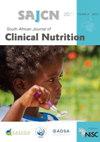Eat clean and safe food: a food-based dietary guideline for the elderly in South Africa
IF 0.6
Q4 NUTRITION & DIETETICS
引用次数: 1
Abstract
As the population of elderly individuals in South Africa (SA) grows, there is a need to promote the continued health of these persons as they progress through the life cycle. Food Based Dietary Guidelines (FBDGs) for the SA elderly were developed to address this need. These thirteen guidelines for the elderly collectively offer a basis of health practices that the elderly can follow to ensure that they are taking the right steps toward maintaining their health. While the guideline ‘Eat clean and safe food’ is not included in the current SA FBDGs, this recommendation is of particular importance to the elderly, who face a much higher risk of foodborne illness than most of the general population due to a number of factors. Reduced immunity and other physiological changes are a result of ageing, malnutrition, diseases and and/or medication side effects. All these factors play a role in the elderly’s risk of foodborne illness. Increased susceptibility to certain pathogens also causes higher rates of foodborne illness infection. Lastly, elderly people’s food safety knowledge and pre-established beliefs and practices regarding food handling and preparation can be influential in their sensitivity to foodborne disease. These risk factors, coupled with the heavy burden of foodborne illness and existing gaps in food safety policy, practices and education in SA, substantiate the need for a dietary guideline to address the importance of clean and safe food consumption among the elderly in SA.吃干净安全的食物:南非老年人饮食指南
随着南非老年人人口的增长,有必要促进这些人在整个生命周期中的持续健康。为满足这一需求,制定了以食物为基础的膳食指南(fbdg)。这13项老年人准则共同提供了老年人可以遵循的保健做法的基础,以确保他们采取正确的步骤来保持健康。虽然“吃干净和安全的食物”的指导方针没有包括在目前的SA fbdg中,但这一建议对老年人特别重要,因为由于许多因素,老年人患食源性疾病的风险比大多数普通人群高得多。免疫力下降和其他生理变化是衰老、营养不良、疾病和/或药物副作用的结果。所有这些因素都在老年人患食源性疾病的风险中发挥作用。对某些病原体的易感性增加也导致食源性疾病感染率上升。最后,老年人的食品安全知识以及关于食品处理和制备的既定信念和做法可能影响他们对食源性疾病的敏感性。这些风险因素,再加上南非食源性疾病的沉重负担和食品安全政策、实践和教育方面的现有差距,证实了制定膳食指南的必要性,以解决南非老年人清洁和安全食品消费的重要性。
本文章由计算机程序翻译,如有差异,请以英文原文为准。
求助全文
约1分钟内获得全文
求助全文
来源期刊

South African Journal of Clinical Nutrition
NUTRITION & DIETETICS-
CiteScore
2.50
自引率
9.10%
发文量
21
期刊介绍:
1.The Journal accepts articles from all basic and applied areas of dietetics and human nutrition, including clinical nutrition, community nutrition, food science, food policy, food service management, nutrition policy and public health nutrition. 2.The Journal has a broad interpretation of the field of nutrition and recognizes that there are many factors that determine nutritional status and that need to be the subject of scientific investigation and reported in the Journal. 3.The Journal seeks to serve a broad readership and to provide information that will be useful to the scientific community, the academic community, government and non-government stakeholders in the nutrition field, policy makers and industry.
 求助内容:
求助内容: 应助结果提醒方式:
应助结果提醒方式:


